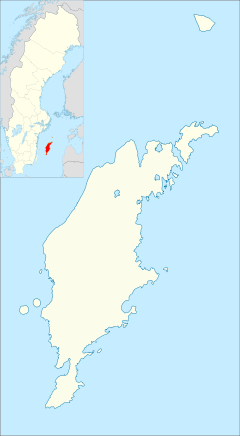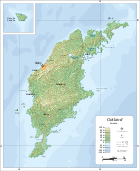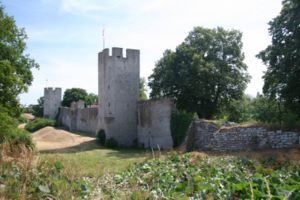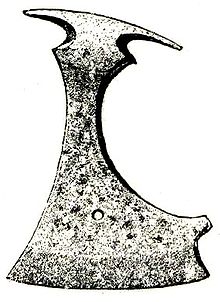- Gotland
-
For the Swedish warships, see HMS Gotland.
Gotland 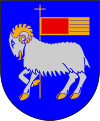
Coat of ArmsGeography Location Baltic Sea Coordinates 57°30′N 18°33′E / 57.5°N 18.55°E Area 3,183.7 km2 (1,229.23 sq mi) Country County Gotland County Municipality Gotland Municipality Largest city Visby (pop. 22,236[1]) Demographics Population 57,221[2] (as of 2009) Density 18.25 /km2 (47.27 /sq mi) Ethnic groups Gotlanders, Swedes Gotland (Swedish pronunciation: [ˈɡɔtˈland] (
 listen)) (Gutnish: Gutland) is a county, province, municipality and diocese of Sweden; it is Sweden's largest island and the largest island in the Baltic Sea. At 3,140 square kilometers in area, the region makes up less than one percent of Sweden's total land area. The region also includes the small islands of Fårö and Gotska Sandön to the north, and some tiny islands, including the Karlsö Islands (Lilla and Stora) to the west. The island of Gotland has an area of 2,994 km², the province has 3,183.7 km² (3,151 km² of land excluding the lakes and rivers).[3] The population is 57,221[2] with about 22,200 living in Visby, the main town.[1] The main sources of income to the island are tourism, agriculture and concrete production from locally mined limestone.
listen)) (Gutnish: Gutland) is a county, province, municipality and diocese of Sweden; it is Sweden's largest island and the largest island in the Baltic Sea. At 3,140 square kilometers in area, the region makes up less than one percent of Sweden's total land area. The region also includes the small islands of Fårö and Gotska Sandön to the north, and some tiny islands, including the Karlsö Islands (Lilla and Stora) to the west. The island of Gotland has an area of 2,994 km², the province has 3,183.7 km² (3,151 km² of land excluding the lakes and rivers).[3] The population is 57,221[2] with about 22,200 living in Visby, the main town.[1] The main sources of income to the island are tourism, agriculture and concrete production from locally mined limestone.Contents
Administration
The traditional provinces of Sweden serve no administrative or political purposes, but are historical and cultural entities. In the case of Gotland, however, due to its insular position, the administrative county, län, Gotland County and the municipality, kommun, Gotland Municipality both cover the same territory as the province. Furthermore, the Diocese of Visby is also congruent with the province.
Heraldry
Gotland was granted its arms in about 1560, even though the island was at the time part of Denmark.[4] The coat of arms is represented with a ducal coronet. Blazon: "Azure a ram statant Argent armed Or holding on a cross-staff of the same a banner Gules bordered and with five tails of the third." The county was granted the same coat of arms in 1936. The municipality, created in 1971, uses the same picture, but with other tinctures.
The Gotlandic flag displays the Gotlandic coat of arms, white on red ground, known from the 13th century in the shape of the seal of the Gutnish Republic with the proud ram. It reads: "Gutenses signo xpistus signatur in agno". This can be translated as follows: "I (the ram) am the sign of the Gutes. The lamb symbolizes Christ".
Geography
Visby is the seat of the municipality as well as the capital of the county. It has a population of approximately 22,200,[1] around two fifths of the island's population.
Gotland is located about 90 km east of the Swedish mainland and about 130 km from the Baltic States, Latvia being the nearest. The island Gotland is obviously just one island, but the historical province of Gotland also includes adjacent islands, which are often considered part of the Gotlandic culture:
- Furillen
- Fårö
- Gotska Sandön, a National park of Sweden
- The Karlsö Islands (Stora Karlsö and Lilla Karlsö)
- Laus holmar
- Utholmen
- Östergarnsholm
There are several shallow lakes located near shores of the island. The biggest is Lake Bästeträsk, located near Fleringe in the northern part of Gotland.
Gotland contains many popular beaches, such a Tofta Strand, and Hundfria strand.
The highest point of the island is Lojsta Hed which stands 82 m above sea level.
Geology
Main article: Geology of Gotland A Silurian reef complex.
A Silurian reef complex.
Gotland is made up of a sequence of sedimentary rocks of a Silurian age, dipping to the south-east. The main Silurian succession of limestones and shales comprises thirteen units spanning 200–500 m of stratigraphic thickness, being thickest in the south, and overlies a 75–125 m thick Ordovician sequence.[5] It was deposited in a shallow, hot and salty sea, on the edge of an equatorial continent.[6] The water depth never exceeded 175–200 m,[7] and shallowed over time as bioherm detritus, and terrestrial sediments, filled the basin. Reef growth started in the Llandovery, when the sea was 50–100 m deep, and reefs continued to dominate the sedimentary record.[5] Some sandstones are present in the youngest rocks towards the south of the island, which represent sand bars deposited very close to the shore line.[8]
The lime rocks have been weathered into characteristic karstic rock formations known as rauks. Fossils, mainly of rugose corals and brachiopods, are abundant throughout the island; palæo-sea-stacks are preserved in places.[9]
History
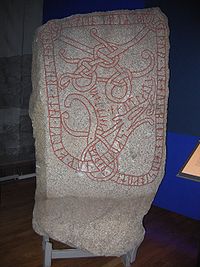 This is the Torsätra runestone (U 614) which was raised in memory of one of the Swedish king's tribute collectors who fell ill and died during a trip to Gotland. It is in the Swedish Museum of National Antiquities in Stockholm.
This is the Torsätra runestone (U 614) which was raised in memory of one of the Swedish king's tribute collectors who fell ill and died during a trip to Gotland. It is in the Swedish Museum of National Antiquities in Stockholm.
The island is the home of the Gutes (the tribal name of the Gotlandic people), and sites such as Ajvide show that it has been occupied since prehistory. Early on, Gotland became a commercial center and the town of Visby was the most important Hanseatic city in the Baltic Sea. In late medieval times, the island had twenty district courts (tings), each represented by its elected judge at the island-ting, called landsting. New laws were decided at the landsting, which also took other decisions regarding the island as a whole.
The Gutasaga contains legends of how the island was settled by Þieluar and populated by his descendants. It also tells that a third of the population had to emigrate and settle in southern Europe, a tradition associated with the migration of the Goths, whose name has the same origin as Gutes, the native name of the people of the island. It later tells that the Gutes voluntarily submitted to the king of Sweden and asserts that the submission was based on mutual agreement, and notes the duties and obligations of the Swedish King and Bishop in relationship to Gotland. It is therefore not only an effort to write down the history of Gotland, but also an effort to assert Gotland's independence from Sweden.
It gives Awair Strabain as the name of the man who arranged the mutually beneficial agreement with the king of Sweden; the event would have taken place before the end of the 9th century, when Wulfstan of Hedeby reported that the island was subject to the Swedes:
Then, after the land of the Burgundians, we had on our left the lands that have been called from the earliest times Blekingey, and Meore, and Eowland, and Gotland, all which territory is subject to the Sweons; and Weonodland was all the way on our right, as far as Weissel-mouth.[10]
The region is considered by some historians to be the original homeland of the Goths.[11]
The city of Visby and rest of the island were governed separately, and a civil war caused by conflicts between the German merchants in Visby and the peasants they traded with in the countryside had to be put down by King Magnus III of Sweden in 1288. In 1361, Valdemar Atterdag of Denmark invaded the island. The Victual Brothers occupied the island in 1394 to set up a stronghold as a headquarters of their own in Visby. At last, Gotland became a fiefdom of the Teutonic Knights, awarded to them on the condition that they expel the piratical Victual Brothers from their fortified sanctuary. An invading army of Teutonic Knights conquered the island in 1398, destroying Visby and driving the Victual Brothers from Gotland. In 1409 Grand Master Ulrich von Jungingen of the Teutonic Knights guaranteed peace with the Kalmar Union of Scandinavia by selling the island of Gotland to Queen Margaret of Denmark, Norway and Sweden.
The number of Arab dirhams discovered on the island of Gotland alone is astoundingly high. In the various hoards located around the island, there are more of these silver coins than at any other site in Western Eurasia. The total sum is almost as great as the number that has been unearthed in the entire Muslim world. These coins moved north through trade between Rus merchants and the Abbasid Caliphate, along the Silver-Fur Road, and the money made by Scandinavian merchants would help northern Europe, especially Viking Scandinavia and the Carolingian Empire, as major commercial centers for the next several centuries.
The Berezan' Runestone, discovered in 1905 in Ukraine, was made by a Varangian (Viking) trader named Grani in memory of his business partner Karl. It is assumed that they were from Gotland.
The authority of the landsting was successively eroded after the island was occupied by the Teutonic Order, then sold to Eric of Pomerania and after 1449 ruled by Danish governors. In late medieval times, the ting consisted of twelve representatives for the farmers, free-holders or tenants. Since the Treaty of Brömsebro in 1645, the island has remained under Swedish rule.
Culture
The medieval town of Visby has been entered as a site of the UNESCO World heritage programme. An impressive feature of Visby is the fortress wall that surrounds the old city, dating from the time of the Hanseatic League.
The inhabitants of Gotland traditionally spoke their own language, known as Gutnish. Today however, they have adapted a dialect of Swedish that is known as "Gotländska". In the 13th century, a work containing the laws of the island, called "The Gotlandic law" (Gutalagen), was published in the ancient Gutnish language.
Gotland is famous for its 94 medieval churches,[12] most of which are restored and in active use. These churches exhibit two major styles of architecture: Romanesque and Gothic. The older churches were constructed in the Romanesque style from 1150–1250 AD. The newer churches were constructed in the Gothic architectural style that prevailed from about 1250-1400 AD. The oldest painting inside one of the churches on Gotland stretches as far back in time as the 12th century.
 The valknut symbol has its most discovered examples on Gotland.
The valknut symbol has its most discovered examples on Gotland.
Traditional games of skill like Kubb, Pärk, and Varpa are played on Gotland. They are part of what has become called "Gutniska Lekar", and are performed preferably on the Midsummer’s Eve celebration on the island, but also throughout the summer months. The games have widespread renown; some of them are played by people as far away as in the United States.
The knotwork design subsequently named the "Valknut" has the most attested historic instances on picture stones in Gotland, which include being on both the Stora Hammars I and the Tängelgårda stones. There are also thousands of mysterious grooves on the island that are suspected of having been used for archaeoastronomy.
Gotland also has a rich heritage of folklore, including myths about the bysen, Di sma undar jordi, Hoburgsgubben and the Martebo lights.
Gotland competes in the biennial Island Games, which it hosted in 1999.
Notable Gotlanders
- Christopher Polhem (1661–1751), the father of Swedish mechanical physics, was born in Visby. He was also called the "Archimedes of the North".
- Swedish film director Ingmar Bergman lived on Fårö, the small island directly north of Gotland Island.
- Former ice hockey player in the NHL, Håkan Loob.
- Lennart Eriksson, also known as Fjodor, the former punk star from Ebba Grön, moved to Gotland soon after he left the band in 1982.
- Singer Susanne Alfvengren, famous in Sweden during the 1980s.
- Death metal band Grave hails from Visby.
- Cyclist Thomas Lövkvist is from Visby. He is occasionally referred to by his nickname Gotland.
- Singer/composer/musician Theresa Andersson, currently living/working in the U.S.
- Hjördis Petterson, actress
- Mats Karlsson, Pharmacometrician, First professor of pharmacometrics in the world
References in popular culture
The Long Ships, or Red Orm (original title: Röde Orm), a best-selling Swedish novel written by Frans Gunnar Bengtsson, contains a vivid description of Gotland in the Viking period. A section of the book is devoted to a Viking ship setting out to Russia, stopping on its way at Gotland and engaging a pilot from the island who plays an important part in their voyage. Gotlanders of the Viking Era are depicted as city people, more sophisticated and cosmopolitan than other Scandinavians of their time, and proud of their knowledge and skills.
The crime novels of Mari Jungstedt, featuring Detective Superintendent Anders Knutas, are set on Gotland.
In the Battlefield Vietnam modification Invasion Gotland, the Soviet army invades Gotland in 1977.
Sports events
- Gotland Runt-sailing event around the island of Gotland
- Gotland Grand National (GGN) is an annual enduro race on Gotland. GGN is a part of the Swedish enduroklassikern (enduro classics, Ränneslättsloppet, Stångebroslaget and Gotland Grand National)
Sports organisations
Football in the province is administered by Gotlands Fotbollförbund. The leading football club is FC Gute.
See also
- Visby
- Vavle
- Scandza
- Gotlanders
- Old Gutnish
- Gutnish
- Gutasaga
- Swedes (Germanic tribe)
- Goths
- Gothic language
- Gothic alphabet
- Geats
- Danes (Germanic tribe)
- Proto-Norse language
- Old Norse
- Viking
- Norsemen
- Hanseatic League
- Swedes
- Sweden proper
- Sweden
- Danes
- Denmark
- Scandinavians
- Scandinavia
- Germanic peoples
References
- ^ a b c Statistics Sweden (as of December 31, 2005)
- ^ a b Statistics Sweden (as of December 31, 2009)
- ^ Statistisk årsbok för Sverige 2009
- ^ Clara Nevéus, Bror jacques de Wærn: Ny svensk vapenbok, 1992
- ^ a b Laufeld, S. (1974). Silurian Chitinozoa from Gotland. Fossils and Strata. Universitetsforlaget.
- ^ Creer 1973
- ^ Gray, Laufield & Boucot, 1974
- ^ Long, D.G.F. (1993). "The Burgsvik beds, an Upper Silurian storm generated sand ridge complex in southern Gotland". Geologiska Föreningens i Stockholms Förhandlingar (GFF) 115 (4): 299–309. ISSN 0016-786X.
- ^ Laufeld, Sven; Martinsson, Anders (22–28 August 1981). "Reefs and ultrashallow environments. Guidebook to the field excursions in the Silurian of Gotland". Project Ecostratigraphy Plenary Meeting.
- ^ "Discovery of Muscovy by Richard Hakluyt - Project Gutenberg". Gutenberg.org. 2003-05-01. http://www.gutenberg.org/etext/4076. Retrieved 2010-08-11.
- ^ See Goths and Scandza for more information on this matter.
- ^ Gotland is famous for its 94 medieval churches
External links
- Important years in Gotland's history
- Portal on Gotland with many, many pictures
- Portal on Gotland
- Official Gotland Tourist Association
- All about Gotland on the Internet
- Picture pages about life in eastern Gotland — Oestergarnslandet (Swedish)
- Gotland (Swedish)
- Gotland (Swedish)
- Gotland (Interlingua)
- Interactive map of Gotland (Swedish)
Provinces (landskap) of Sweden 
Inhabited islands in the Baltic Sea Denmark Estonia Finland Archipelago Sea Islands (Åland Islands) · Hailuoto · Kimitoön · Laajasalo · Lauttasaari · Replot · SuomenlinnaGermany Poland Russia Sweden Categories:- Articles with Interlingua language external links
- Gotland
- Provinces of Sweden
Wikimedia Foundation. 2010.

